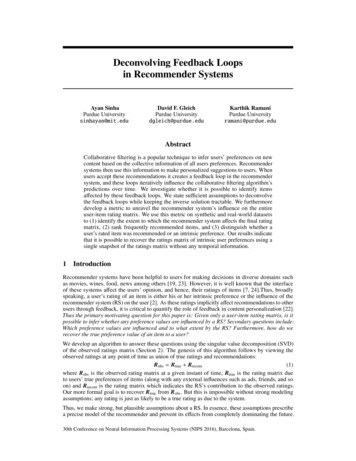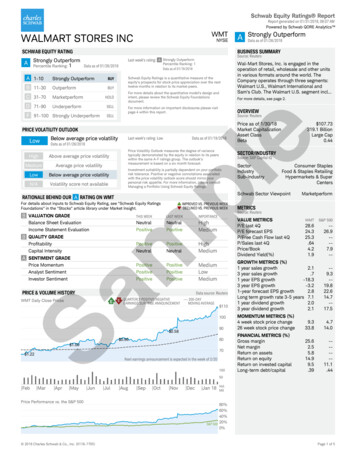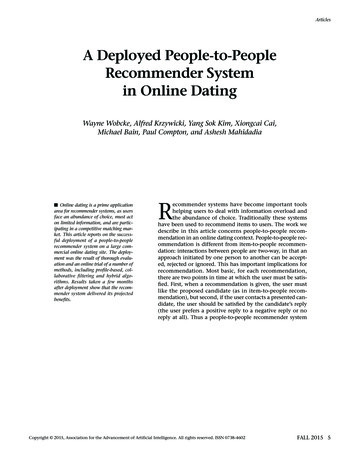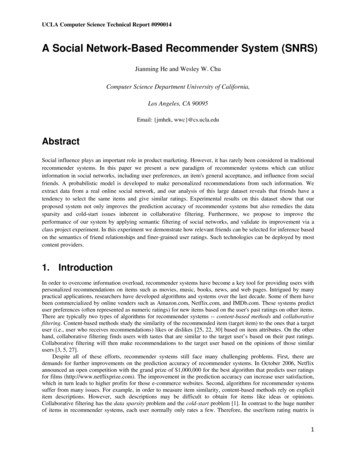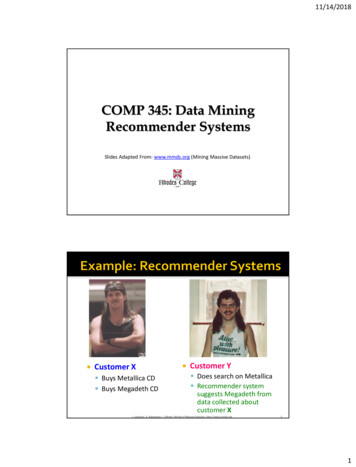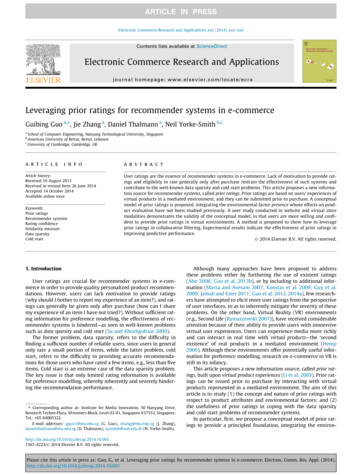
Transcription
Electronic Commerce Research and Applications xxx (2014) xxx–xxxContents lists available at ScienceDirectElectronic Commerce Research and Applicationsjournal homepage: www.elsevier.com/locate/ecraLeveraging prior ratings for recommender systems in e-commerceGuibing Guo a, , Jie Zhang a, Daniel Thalmann a, Neil Yorke-Smith b,caSchool of Computer Engineering, Nanyang Technological University, SingaporeAmerican University of Beirut, Beirut, LebanoncUniversity of Cambridge, Cambridge, UKba r t i c l ei n f oArticle history:Received 16 August 2013Received in revised form 26 June 2014Accepted 14 October 2014Available online xxxxKeywords:Prior ratingsRecommender systemsRating confidenceSimilarity measureData sparsityCold starta b s t r a c tUser ratings are the essence of recommender systems in e-commerce. Lack of motivation to provide ratings and eligibility to rate generally only after purchase restrain the effectiveness of such systems andcontribute to the well-known data sparsity and cold start problems. This article proposes a new information source for recommender systems, called prior ratings. Prior ratings are based on users’ experiences ofvirtual products in a mediated environment, and they can be submitted prior to purchase. A conceptualmodel of prior ratings is proposed, integrating the environmental factor presence whose effects on product evaluation have not been studied previously. A user study conducted in website and virtual storemodalities demonstrates the validity of the conceptual model, in that users are more willing and confident to provide prior ratings in virtual environments. A method is proposed to show how to leverageprior ratings in collaborative filtering. Experimental results indicate the effectiveness of prior ratings inimproving predictive performance.Ó 2014 Elsevier B.V. All rights reserved.1. IntroductionUser ratings are crucial for recommender systems in e-commerce in order to provide quality personalized product recommendations. However, users can lack motivation to provide ratings(why should I bother to report my experience of an item?), and ratings can generally be given only after purchase (how can I sharemy experience of an item I have not tried?). Without sufficient rating information for preference modelling, the effectiveness of recommender systems is hindered—as seen in well-known problemssuch as data sparsity and cold start (Su and Khoshgoftaar 2009).The former problem, data sparsity, refers to the difficulty infinding a sufficient number of reliable users, since users in generalonly rate a small portion of items, while the latter problem, coldstart, refers to the difficulty in providing accurate recommendations for those users who have rated a few items, e.g., less than fiveitems. Cold start is an extreme case of the data sparsity problem.The key issue is that only limited rating information is availablefor preference modelling, whereby inherently and severely hindering the recommendation performance. Corresponding author at: Institute for Media Innovation, 50 Nanyang Drive,Research Techno Plaza, XFrontiers Block, Level 03-01, Singapore 637553, Singapore.Tel.: 65 84005322.E-mail addresses: gguo1@ntu.edu.sg (G. Guo), zhangj@ntu.edu.sg (J. Zhang),danielthalmann@ntu.edu.sg (D. Thalmann), nysmith@aub.edu.lb (N. Yorke-Smith).Although many approaches have been proposed to addressthese problems either by furthering the use of existent ratings(Ahn 2008; Guo et al. 2013b), or by including to additional information (Massa and Avesani 2007; Konstas et al. 2009; Guy et al.2009; Jamali and Ester 2011; Guo et al. 2012, 2014a), few researchers have attempted to elicit more user ratings from the perspectiveof user interfaces, so as to inherently mitigate the severity of theseproblems. On the other hand, Virtual Reality (VR) environments(e.g., Second Life (Rymaszewski 2007)), have received considerableattention because of their ability to provide users with immersivevirtual user experiences. Users can experience media more richlyand can interact in real time with virtual products—the ‘secondexistence’ of real products in a mediated environment (Hemp2006). Although these environments offer potentially useful information for preference modelling, research on e-commerce in VR isstill in its infancy.This article proposes a new information source, called prior ratings, built upon virtual product experiences (Li et al. 2003). Prior ratings can be issued prior to purchase by interacting with virtualproducts represented in a mediated environment. The aim of thisarticle is to study (1) the concept and nature of prior ratings withrespect to product attributes and environmental factors; and (2)the usefulness of prior ratings in coping with the data sparsityand cold start problems of recommender systems.In particular, first, we propose a conceptual model of prior ratings to provide a principled foundation, integrating the .0031567-4223/Ó 2014 Elsevier B.V. All rights reserved.Please cite this article in press as: Guo, G., et al. Leveraging prior ratings for recommender systems in e-commerce. Electron. Comm. Res. Appl. 003
2G. Guo et al. / Electronic Commerce Research and Applications xxx (2014) xxx–xxxmental factor presence whose effects on product evaluation havenot been studied previously. Five hypotheses and two researchquestions are proposed to verify the validity of the conceptualmodel. We recruited volunteers and performed user studies in both2D (website) and 3D (virtual store) user interface modalities. Theresults demonstrate the validity of the conceptual model underour experimental settings, and indicate that users are more willingand confident to give prior ratings in a VR store (due to a strongersense of presence) than in a website.Then, second, by integrating the prior rating and confidence datacollected from the user studies into a novel adapted collaborative filtering technique that we develop, we empirically demonstrate theusefulness of prior ratings in improving recommendationperformance in terms of accuracy and coverage.Our work sheds light on inherently alleviating the data sparsityand cold start problems by the design of user interfaces with richmedia and interactions that elicit confident prior ratings fromusers.Contribution. Summarized, the major contributions of this article are in three-fold: (1) we introduce a new information source(and its conceptual model) called prior ratings, which holds potential to benefit recommender systems in e-commerce; (2) we designa user study to validate the conceptual model of prior ratings; and(3) we propose and evaluate a collaborative filtering technique todemonstrate how to leverage prior ratings in predicting the ratingsof products. A preliminary version of our work is published in (Guoet al. 2013a).Outline. Section 2 gives an overview of related research in theliterature. Section 3 details the proposed conceptual model of priorratings, and proposes five related hypotheses and two researchquestions. Section 4 reports on a user study designed to validatethe conceptual model. Then, Section 5 discusses the relationshipbetween prior ratings and other information sources for recommender systems, and the limitations and implications of the userstudy and results. Based on the rating and confidence data collected from the user study, Section 6 introduces a variant of traditional collaborative filtering technique and demonstrates theusefulness of prior ratings in improving predictive performance.Finally, Section 7 concludes our work and outlines the futureresearch.2. Related workMany approaches have been proposed to resolve the data sparsity and cold start problems. From the perspective of informationsource, we classify them into two categories. The first categoryadopts rating information only. There are two kinds of approaches,memory-based and model-based. For memory-based methods,various authors have proposed new similarity measures to bettermodel user correlation to resolve the concerned issues, given theinefficiency of traditional similarity measures (Lathia et al. 2008).Specifically, Lathia et al. (2008) propose a concordance-based measure based on the amount of concordant, discordant and tied pairsof ratings between two users. It measures the extent to which thetwo users agree with each other. Ahn (2008) develops the PIP measure by studying the semantics of ratings in terms of Proximity,Impact and Popularity. The basic idea is that users with semanticagreements should be more similar than those with semantic disagreements. Bobadilla et al. (2012) design the singularities measurefrom the perspective of item singularity. The intuition behind isthat ratings agreed on high-singular items should be counted morethan those agreed on low-singular items in computing user similarity. Guo et al. (2013b) propose a novel Bayesian similarity by taking into account both the direction and length of rating vectors.The weights of evidences (i.e., rating pairs) are carefully computedand integrated into the Bayesian inference. Experimental resultsshow that better performance can be achieved than the other similarity measures.However, memory-based approaches do not scale well to largescale data sets. In contrast, model-based methods possess betterscalability and often perform better than memory-based ones(Koren et al. 2009). The reason is that not only ratings of two usersbut also ratings of other users are adopted to learn the features ofusers and items, and thus better handle the data sparsity and coldstart issues. Gunawardana and Meek (2008) report to capture pairwise item interactions by using a Boltzmann machine, whoseparameters are associated with item contents. They show that better performance is achieved in the case of cold-start situations.Gantner et al. (2010) attempt to learn a function mapping user/item attributes to latent features of a matrix factorization model.With such mappings, the latent factors learned by a matrix factorization can be applied to new users or new items. Liu et al. (2011)propose a representative-based matrix factorization method thataims to find out the most representative users and items in the system. Then, for the cold-start users, their preferences can be elicitedby asking them to rate the most representative items; the sameholds for the cold-start items. To combat the data sparsity problem,Ahmed et al. (2013) propose a method to learn user preferencesover item attributes by applying a personalized Bayesian hierarchical model, which combines both globally and locally learned userpreferences.In summary, all these approaches, both memory-based andmodel-based, attempt to integrate user/item attributes into a certain recommendation model in order to handle the concernedissues. However, the attributes of users/items may not be availablefor a recommender system due to the concern of, e.g., privacy.The second category adopts additional information other thanratings. For example, Konstas et al. (2009) take into considerationboth the social annotation (tag) and friendships inherently established among users in a music track recommender system. Byleveraging data from multiple channels including membershipsin a project, Guy et al. (2009) build a system for recommendingpeople of interest to active users. Ma et al. (2011) propose a matrixfactorization model regularized by users’ social friendships. Theintuition is that a user-specific vector should be close to that ofhis friends. A stronger relationship than friendship is social trust,based on which Massa and Avesani (2007) develop a trust-awarerecommender system. They show that data sparsity can be betterhandled without a significant decrement in predictive accuracy.Guo et al. (2014b) define trust in recommender systems as one’sbelief in the other’s ability in providing accurate ratings. Guoet al. (2012, 2014a) merge the ratings of trusted neighbours toform a new rating profile for the active users by which the concerned problems are shown to be alleviated.Other than these memory-based approaches, trust is also integrated into matrix factorization models for better recommendationperformance. Ma et al. (2009) propose the social trust ensemblethat forms a linear combination of a matrix factorization modeland a trust-based neighbourhood model. Jamali and Ester (2010)propose a matrix factorization model where a user’s user-specificvector is influenced by the average of her trusted neighbours.Tang et al. (2013) take into account both the global and local trustin the recommendation model, and show that predictive performance can be improved to some extent. Yang et al. (2013) reportthat the active user’s ratings will be influenced by the ratings ofusers who trust her and those who she trusts. Experimental resultsshow that their approach works the best among all other trustbased approaches. One of the problems of matrix factorizationmodels lies in the difficulty of explaining how recommendationsare generated, as these patterns are based on latent features.Another problem is that users’ social information may not exist,Please cite this article in press as: Guo, G., et al. Leveraging prior ratings for recommender systems in e-commerce. Electron. Comm. Res. Appl. 003
G. Guo et al. / Electronic Commerce Research and Applications xxx (2014) xxx–xxxespecially for the applications without built-in or linked social networks. Further, such information merely indirectly implies userpreference, e.g., friends may or may not have similar preferences,and hence could be error-prone.Therefore, although additional information sources such asfriendship and trust have been widely applied in (social) recommender systems and although improvements have been demonstrated to some extent, the cold start problem remains a difficultissue to address. The reasons can be explained in three aspects.First, these kinds of information suffer from a number of inherentissues. As explained above, the semantics of friendship are ambiguous and error-prone. For example, friends may have differentpreferences because friendships can be built based on other relations (e.g., working affiliation) rather than common interest initems. It is usually low cost for a user to get connections with otherusers or even strangers (e.g., Facebook). Trust is only supported byfew real systems (e.g., epinions.com and ciao.co.uk). Trust information is also very sparse (Guo et al. 2014b), i.e., the density of trustinformation is even much smaller than that of rating informationin the same data set, since not all users who give ratings will besocially connected with other users. In many other systems, trustinformation is not available and thus it has to infer trust fromusers’ behavioural patterns (Guo et al. 2014b,c). Another problemof social relationships is that they usually exist in the forms ofsocial connections with no connection strength specified or available. For example, in trust networks, we only know the relationships about who trust whom, but it is unknown to what extentone will trust another. One explanation is due to the concern of,e.g., privacy. It is a commonplace that not all socially connectedusers should be equally weighted for recommendations. Fanget al. (2014) suggest to refine the trust values by training a supportvector regression model based on four general decomposed trustfactors, before taking as input to a matrix factorization model. Theyshow that better performance can be achieved based on the refinedtrust values. The unweighted social relationships may further limitthe utility of social recommender systems. Second, for ‘extremely’cold users who have rated no items and linked to no one, it is difficult for a social recommender to provide accurate personalizedrecommendations. This is because user preferences cannot beinferred and modeled from their past behaviours. Third, even withthe social information, the performance of cold users is still muchworse than that of normal users, as demonstrated by the work ofYang et al. (2013). There is much room left for better recommendation performance. Hence, the cold start problem has not been wellhandled by the existing approaches and information sources. Moreefforts are required to further alleviate the cold start problem,including developing more advanced recommendation algorithmsand designing new information sources.Our work follows the second category, i.e., incorporating additional information in recommender systems, but differs in thatwe focus on introducing a new information source rather thanthe specific techniques to utilize such information. However, wedo design a collaborative filtering technique to demonstrate theuse of prior ratings.Only a few works have attempted to study the concerned problems from the perspective of user interfaces. For example, Careniniet al. (2003) recognize that traditional recommender systems support only a limited model of interaction to elicit new users’ ratings.They explore a set of elicitation techniques leading to a more conversational and collaborative interaction model. Offline experiments show that the effectiveness of recommender systems canbe improved by applying these techniques. However, whetherthe new model of interaction is accepted by users and useful foronline recommendations in practice is unknown. McNee et al.(2003) find that allowing systems to choose items for new usersto rate works better than letting users choose the items, in order3to bootstrap and build a recommendation model. Dong et al.(2012) develop a browser plugin to provide users with suggestionson writing better product reviews. Other users can hence betterunderstand the performance of products before making a purchasedecision. Most of these studies focus on interface design or assistance, so that users are more comfortable, enabled, or loyal in providing ratings. They are not particularly dedicated to resolving thetwo concerned recommender systems problems. By contrast, ourmotivation is to tackle the concerned problems through a newinformation source in a richer virtual environment.Contemporary websites are implementing novel interfaces andinteractions to better elicit user preferences. For example, brides.com allows users to virtually try on wedding dresses by uploading their own photos and adjusting the specific positions of dressesto fit. As another example, ray-ban.com offers users a virtual mirrorthrough which users can calibrate their faces using a computercamera, and virtually try on different kinds of glasses. However,the available media and interactions are limited in comparisonwith the capabilities of virtual reality (VR) (e.g., Second Life(Rymaszewski 2007)). The emergence of 3D VR environmentsoffers more adequate information which can be used to model userpreference. Although the need to design new recommender agentsfor e-commerce in VR has been recognized (Xiao and Benbasat2007), research on recommender systems in VR is still in itsinfancy. Eno et al. (2011) summarize several ways to model userpreferences in VR. Shah et al. (2010) recommend to users locationsof interest by analyzing users’ login data to help them navigate inVR. Hu and Wang (2010) propose a system for virtual furniture recommendation according to users’ interest and requirements.Although a controlled prototype implemented, the features of VRare not exploited to elicit more user ratings.In this article we propose prior ratings as a means to make useof the information conveyed by the rich media and the real-timeinteractions in VR. Prior ratings represent a new informationsource distinct from the existing information sources noted earlier.First, prior ratings are issued by real users: hence they directlyreflect users’ preferences of products as well as standard type ofuser ratings. In this regard, they could be more reliable than otherkinds of information, such as friendship and trust. Second, priorratings differ from other extra information sources in that theydo not depend on additional structures (e.g., social network) asrequired by the latter. Prior ratings only rely on the representationsof virtual products in mediated environments, but these environments are the commonplace basis of e-commerce applications.Prior ratings are useful to deal with data sparsity and cold startbecause (1) more user ratings are incorporated to alleviate thesparsity of data; and (2) prior ratings can help model user preferences even if posterior ratings are few or none, and thus ensurethe functionality of the recommenders. To our knowledge, thereis no work that has defined the concept of and investigated theeffectiveness of prior ratings for recommender systems.3. Prior ratingsWe define the term prior ratings as users’ assessment or judgement of preference of products in the light of their virtual productexperiences, referring to the psychological and emotional statesthat users undergo while interacting with virtual products in amediated environment (Li et al. 2003). Hence, prior ratings arereported by users based on their interactions with virtual productsin a mediated environment, and they can be issued prior to purchase or after purchase (if any). Therefore, although we focus onVR environments, prior ratings could be given in any other mediated environments, such as augmented reality, as long as theycan provide reliable virtual product experiences.Please cite this article in press as: Guo, G., et al. Leveraging prior ratings for recommender systems in e-commerce. Electron. Comm. Res. Appl. 003
4G. Guo et al. / Electronic Commerce Research and Applications xxx (2014) xxx–xxxFig. 1. The conceptual model of prior ratings.We refer to the ‘standard’ type of ratings derived from ‘posterior’ product experiences as posterior ratings. By ‘posterior’, wemean experiences of a tangible product obtained via direct trialsor use of the product in a physical environment. Since tangibleproducts can be fully experienced usually only after purchase, posterior ratings are primarily post-purchase ratings. Prior ratings andposterior ratings are distinct and complementary in that theyreflect different forms of user experiences. Note that for productswithout a tangible form, such as streamed movies, since userscan only experience them virtually through some medium, users’ratings are necessarily prior ratings.In this article, two kinds of mediated environments are investigated: traditional 2D websites (WS) and 3D VR environments. Theydiffer in richness of both media and of interactions through whichproduct information can be delivered. WS only supports limitedmedia and user interactions; VR real-time interactions enableusers to possess a strong sense of being in a mediated environmentand gain a lifelike shopping experience (Li et al. 2001). Specifically,products are represented in 3D virtual models through which userscan view, rotate, zoom, customize and even try them on. Considering the rich virtual product experiences that users obtain in VR, weposit that VR will motivate users to express their opinions by providing prior ratings to the products of interest, and hence makemore informative purchase decisions while shopping in VR.Hypothesis 1. Users are more willing to provide prior ratings tothe items (e.g., products) that they have interacted with in VR thanin WS.Although prior ratings can be submitted in both WS and VR aslong as the user interfaces enable the rating functionality, the confidence level may differ. Specifically, due to limited media andinteractions available in WS, users may have less adequate information than in VR as a basis for their ratings. Jiang and Benbasat(2004) also contend that virtual products in VR help improve theperceived diagnosticity of products—the extent to which usersbelieve a particular shopping experience is helpful to understandthe quality and performance of a product. Therefore, users may feelmore capable of forming direct, intuitive and concrete opinionsabout products in VR than in WS in terms of both rating confidenceand rating values.Hypothesis 2. (a) Users have more confidence in providing priorratings in VR than in WS; (b) the average value of prior ratings in VRis closer to that of posterior ratings than that of prior ratings in WS.3.1. Conceptual model of prior ratingsWe now present a conceptual model of prior ratings as shownin Fig. 1. Such a model allows a principled basis for the elicitationand analysis of prior ratings. The objective of our conceptual modelis to investigate a comprehensive understanding of the nature ofprior ratings. Specifically, (1) how prior ratings are given by users,and (2) how other factors such as the presence of virtual reality andthe attributes of virtual products impact on users’ evaluation ofprior ratings. Only after a proper understanding of prior ratings,we will be able to show how to leverage them in a newly-designedcollaborative filtering technique so as to resolve the data sparsityand cold start problems—which are our main concern in this article—in Section 6. Note that the conceptual model is not used to justify the effectiveness of prior ratings in resolving the data sparsityand cold-start problems, but to give a better comprehension ofprior ratings.For a specific product, a number of intrinsic and extrinsic attributes are associated. In different environments, the perceptions ofthese attributes can differ according to the types of media andinteractions that deliver information about them. For example,VR environments may have better perceptions of products thantraditional websites as the former generally enables richer mediaand real-time interactions. The intrinsic and extrinsic perceptionsindicate the quality of products as perceived directly and indirectly, respectively. In contrast, the perceived cost (e.g., time, price)refers to the cost that users have to bear in order to obtain theproducts. A prior rating is an overall evaluation of preference ofproducts in terms of both perceived quality and cost, i.e., a combination of what we ‘get’ and what we ‘give’.We proceed to elaborate the details of the conceptual model inthe following subsections.3.2. PresencePresence is defined as users’ sense of ‘‘being there’’, the extentto which they experience the virtual environments as real or present and temporarily ignore where they are physically present(Slater et al. 2010). Two major determinants have been identified,namely vividness and interactivity (Steuer 1992). First, vividnessreflects the representational richness of a mediated environmentas defined by its formal media through which information can bepresented. Two important elements of vividness are sensorybreadth which refers to the number of sensory dimensions simultaneously presented, and sensory depth which refers to the resolutionwithin each perceptual channel. Second, interactivity is defined as‘‘the extent to which users can participate in modifying the formand content of a mediated environment in real time’’ (Steuer1992). Three important elements, namely speed, range, and mapping describe the specification of a mediated environment in termsof response time, the amount of manipulable attributes, and theprojections between human and environmental actions.Hence, presence in this article is captured as the extent to whichbeing in a mediated environment feels like being in a real environment,1 given the richness in media and interactions. Picciano (2002)reports that the sense of social presence (i.e., the sense of belonging1Compare question 2 for the tested environments in Fig. 3.Please cite this article in press as: Guo, G., et al. Leveraging prior ratings for recommender systems in e-commerce. Electron. Comm. Res. Appl. 003
G. Guo et al. / Electronic Commerce Research and Applications xxx (2014) xxx–xxxin a course and group) has a positive and statistically significantinfluence on the performance of students’ written assignments inan online course. Phang and Kankanhalli (2009) study how the perceptions of virtual world can enhance online learning. They showthat in 3D environments, presence can enhance students’ concentration and enjoyment during the learning process, and thus improvestudents’ learning outcomes. These two works show that (1) it isimportant for learners to perceive a realistic classroom experience;and (2) such sense of being there can help them concentrate moreon the learning contents. In the case of e-commerce recommendations, the presence of virtual reality enables users a lifelike shoppingexperience, and thus users may concentrate more on the productexperience and evaluation. In addition, Heeter (1992) stresses theimportance of being able to change virtual environments, forinstance, moving and painting a 3D object. A higher sense of presence can enable user interactions with 3D environments to be easierand more responsive. In our case, the 3D models of virtual productscan respond to users’ actions, e.g., rotating and zooming, and henceusers may gain more direct comprehension about the properties(attributes) of products. Considering that the information concerningproduct attributes is conveyed by media channels and user interactions, presence can be an important environmental factor that willinfluence the perceptions of product attributes.Hypothesis 3. Presence has positive influence on the perceptionsof both intrinsic and extrinsic attributes.Note that higher sense of presence does not necessarily meanbetter perceived quality. Perceived quality is based on the perceptions of product attributes; presence is a moderator of the perceptions of product attributes.3.3. Intrinsic attributesIntrinsic attributes (e.g., workmanship, size) have a directimpact on perceived quality during the goal-directed process ofpre-purchase product evaluation (Gardial et al. 1994). Goering(1985) also considers
(Ahn 2008; Guo et al. 2013b), or by including to additional infor-mation (Massa and Avesani 2007; Konstas et al. 2009; Guy et al. 2009; Jamali and Ester 2011; Guo et al. 2012, 2014a), few research-ers have attempted to elicit more user ratings from the perspective of user interfaces, so as to inherently mitigate the severity of these problems.
